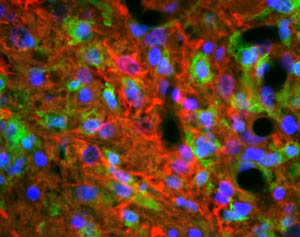Division of Neuroscience
Diversity and Inclusion Statement

The Neuroscience Division at Oregon National Primate Research Center aspires to be a top-tier research community built on innovation, collaboration, and respect. We strive to create a safe and welcoming environment so that diverse perspectives flourish and inform our scientific process. Our rich exchange of ideas, nourished in an inclusive environment , assures our success in creatively addressing the most pressing biomedical diseases and disorders of the nervous system. All members within our community endorse and acknowledge their responsibility to uphold these values.
Overview
The Division of Neuroscience at the ONPRC conducts research aimed at identifying and defining fundamental aspects of the behavioral, cellular and molecular mechanisms underlying nervous system function. The guiding principle of these research efforts is the concept that our nonhuman primate resource can be best utilized by collaborative research efforts across disciplines and with clinical partners to fully exploit the translational value of basic research. The Division has focus areas of study on how sensory and physiological systems interplay with innate, learned and cognitive behaviors. Most areas of research study a specific time in the lifespan, such as in utero, adolescent, adult and aged stages of life. We have particular strength in brain development, neurodegenerative processes, neuroendocrinology and cortical function. Our approaches are taken with the ultimate goal of informing human nervous system disorders and therefore translational platforms are developed and utilized. We are leaders in the use of MRI imaging and translational studies of the brain connectome and work directly with OHSU clinician scientists in these endeavors. We have established chemogenetic and optogenetic approaches to manipulating specific brain activity as well as advancing disease interventions with gene therapeutic approaches. The primary diseases/disorders under study are addiction and substance abuse; obesity and malnourishment; demyelinating diseases; neurogenetic disorders such as Huntington's, Lusher's, Batten's and multiple sclerosis; neuroendocrine processes involved in puberty and menopause; and neuroinflammation. In addition, the Division capitalizes on all resources available at the ONPRC, particularly the pedigreed rhesus and Japanese macaque breeding colonies, the molecular biology core, the viral vector core, the surgical and pathology sections of Animal Resources & Research Support (ARRS). We have strong funding from 8 NIH institutes, foundations and industry, and extensive collaborations with the many clinical departments at OHSU including Anesthesiology, Neurology, Pediatrics, Psychiatry, as well as all the OHSU basic science departments, centers and institutes.
In addition to its basic science activities, the Division of Neuroscience provides specialized research training to graduate students, postdoctoral research fellows, and visiting scientists. Its faculty members hold appointments in, and actively contribute to the OHSU Neuroscience, Behavioral Neuroscience and Molecular and Cellular Biosciences graduate programs. Finally, the Division serves as a regional, national and international resource for integrative neuroscience research because of its unique capabilities to conceptually and translationally link neural functions of nonhuman primates with other animal models of neural disease.
The Division is currently composed of 12 faculty members including 7 Professors, 1 Associate Professor, 3 Assistant Professors and 1 Research Assistant Professor. There are also 9 Affiliate Scientists from various research and clinical departments at OHSU. Altogether, we bring approximately $15 million/year in funding to the ONPRC and OHSU.
Division of Neuroscience Faculty
Affiliates
John V. Brigande, Ph.D., Vollum, Oregon Health & Science University
Martin J. Kelly, Ph.D., Neuroendocrine, Oregon Health & Science University
Jamie Lo, M.D., OBGYN, Placenta, Oregon Health & Science University
Steven Matsumoto, Ph.D., Integrative Biosciences, Oregon Health & Science University
Cynthia McEvoy, Ph.D., Developmental, Oregon Health & Science University
Ilhem Messaoudi, Ph.D., Neuroimmune, University of California-Riverside
Hiroyuki Nakai, M.D., Ph.D., Genetics, Viral Vector, Oregon Health & Science University
Jacob Raber, Ph.D., Aging, Cognition, Oregon Health & Science University
Oline K. Ronnekleiv, Ph.D., Neuroendocrine, Oregon Health & Science University
Elinor L. Sullivan, Ph.D., Psychiatry, Oregon Health & Science University